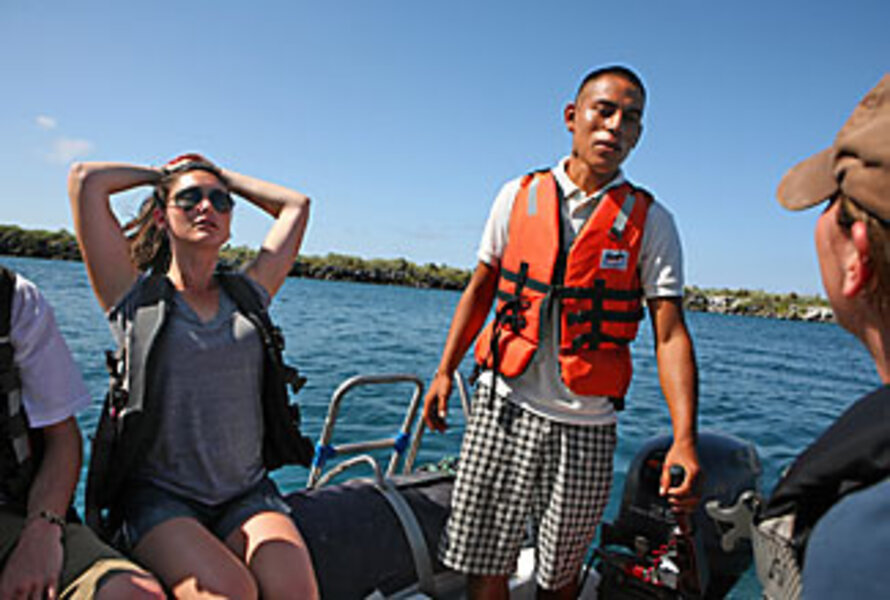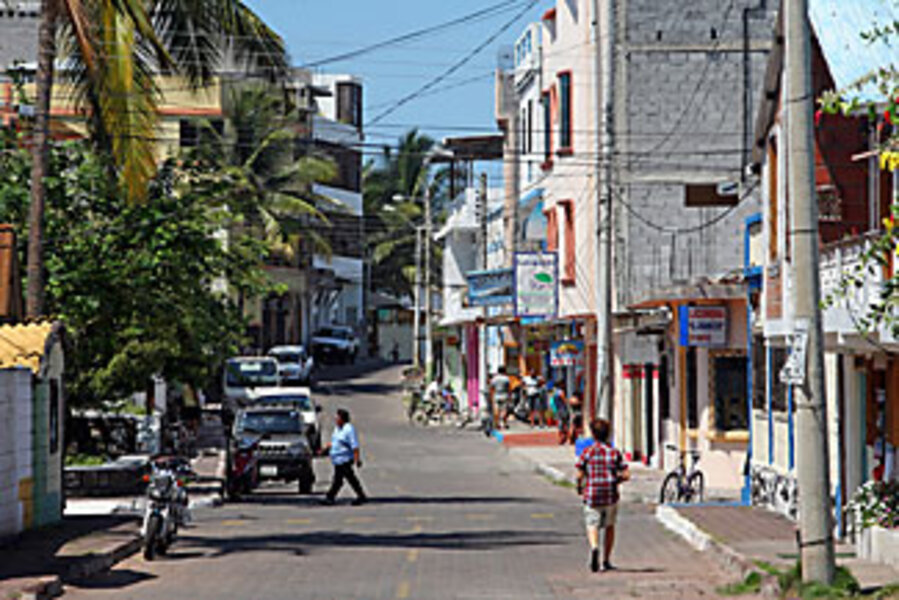Galápagos Islands: Is there room for humans in 'nature's laboratory'?
| Galápagos Islands, Ecuador
Jairo Montenegro grew up in the northern sierras of Ecuador, in the tiny town of Tulcan. He had never set foot on a boat. But in 2001 he moved to the Galápagos Islands, 600 miles off the mainland coast, to work as a crew member on a cruise liner.
In doing so he joined a wave of Ecuadoreans relocating to these remote islands in an economic exodus fueled by high-paying tourism jobs. Mr. Montenegro earns $780 a month on the crew – a small fortune compared with the $120 per month he pocketed as a hotel concierge at home.
But now, in an effort to conserve the islands, officials are tightening migration laws. They have put residency requirements on Ecuadoreans that are, in some ways, as tough as those on foreigners trying to gain citizenship in the United States. Even children born to parents on the islands are not automatically granted permanent residency unless their parents also are permanent residents.
Since the new regulations were put in place, nearly 1,000 have returned to Ecuador, many involuntarily. And in the year of the 200th anniversary of the birth of Charles Darwin, whose voyage to the Galápagos cemented his theory on evolution, the controls have touched off a storm of protest, angering locals who say they are treated as illegal immigrants in their own country and raising questions about balancing human development and ecological preservation.
"The Galápagos belongs to Ecuador," Montenegro says. "Instead, authorities go looking for people in discos, listen to the way we speak in stores to see if we are from somewhere else, as if we were criminals."
Population surge
Nearly all of the sea, coasts, and mountains that make up the Galápagos belong to the national park. Residents can only live within 3 percent of the territory. But within that space, the population has surged.
Santa Cruz is the most populous Galápagos Island. Its main town, Puerto Ayora, resembles any other Latin American city with food stalls, tire shops, and public phone centers lining the streets. Ten years ago about 10,000 people called this city home. Now, because of migration and high birthrates, the number has nearly doubled.
In 2007, the United Nations Educational, Scientific, and Cultural Organization (UNESCO) placed the Galápagos on its list of endangered World Heritage Sites because of overcrowding – they say the islands have a total of 30,000 residents now – and the threats posed by tourism, invasive species, and illegal fishing.
Many are surprised to learn that people actually inhabit "nature's laboratory." Despite its isolation, however, which allowed for the evolution of finches, blue-footed boobies, and playful sea lions that show little fear of tourists, humans have had contact for five centuries here.
New residents continue to arrive, taking advantage of well-paid jobs in tourism, which grows unabated – quadrupling from 1990 to 2008, to more than 170,000 visitors last year. Tourists and residents require more food and fuel each year, and the boats and planes that bring them here also bring with them mosquitoes, flies, rats, and plants that overrun the island's endemic species. According to Ingala, the regional planning office, from January to September of last year, about 5,500 tons of cargo arrived by ship.
"Migration and tourism are among the biggest threats to the Galápagos," says Eliecer Cruz, a former governor of Galápagos who now works with the World Wildlife Fund. Both contribute to invasive species, such as blackberries, which strangle native plants and destroy ecosystems.
Stricter enforcement
Rules on migration were carved into a special law in 1998, but the regulations to enforce them were not signed and implemented until 2007, Mr. Cruz says. With the new rules, residents without the proper residency or work permits were notified they would have to leave. Those who have not complied have been sent home involuntarily with the national police. Checkpoints have become a norm here.
"It's much stricter now than it was before because of overpopulation," says Luis Ordonez, an inspector general with the national police in an interview in Quito. "Now, it's as hard to go there as if you were going to the US."
All of this has not made the head of Ingala, which also oversees migration, well loved. "I know it is hard to see a family member have to leave," says Fabian Zapata, who says the agency was forced to hire a night guard while the new rules were being created because of threats that locals wanted to burn down their offices. "But it is the only way to conserve the islands."
Locals get around the rules as they can, marrying natives for resident cards. That's what Montenegro did – though he insists it was for love. He says he has friends who have taken jobs in the highlands, as opposed to in the port, to hide from officials. Twenty percent of the population was believed to be living here without the proper documentation, before the migration regulations took effect.
Some locals agree with the restrictions. Paolo Jimenez moved here from mainland Ecuador two years ago. He has the proper paperwork now, but when it expires, if it is not renewed, he says he'll go home. "This is not just any place," says the taxi driver. "There is a responsibility."
Balancing development, conservation
The 2007 UNESCO warning drew plenty of attention to the islands conservation problems. But Edgar Munoz, director of the Galápagos National Park Service, says the international community cannot forget that people live here.
Learning how to balance environmental needs with development is a global challenge, and one question that officials say is a daily struggle.
"The people cannot look at the Galápagos as if it were inside a glass enclosure not to be touched," Mr. Munoz says. "Still we have to learn how to live with the least impact possible."
Conservationists are tackling this problem daily. Cristina Georgii, who carries out the education and sustainable development program at the Charles Darwin Foundation in Santa Cruz, works with the school system to incorporate course work on sustainability into the public school curriculum.
The government is seeking to woo fishermen into tourism jobs, so that depleted stocks, such as sea cucumbers, can be replenished. The UNESCO report says that up to 300,000 sharks are caught illegally each year in the waters of the Galápagos for the booming Asian demand for shark-fin soup. Ingala has also launched a job bank to place locals into positions, so that employers don't petition to bring workers from the mainland.
These are small steps, and much bigger ones are needed, conservationists say, including a commitment from the government to conserve the islands, but Cruz says he feels hopeful that with Ecuadorean President Rafael Correa, who ushered in a new constitution last year that enshrines the rights of nature, there is more of a commitment to the Galápagos than ever before. President Correa had highlighted the threats facing Galápagos before the UNESCO warning. "If [Correa] can't do it, no one can," says Cruz.






